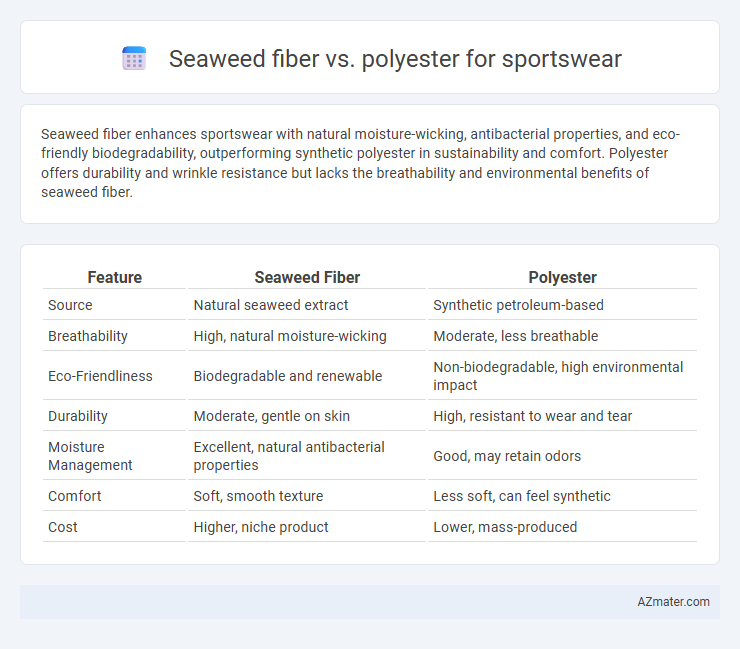Seaweed fiber enhances sportswear with natural moisture-wicking, antibacterial properties, and eco-friendly biodegradability, outperforming synthetic polyester in sustainability and comfort. Polyester offers durability and wrinkle resistance but lacks the breathability and environmental benefits of seaweed fiber.
Table of Comparison
| Feature | Seaweed Fiber | Polyester |
|---|---|---|
| Source | Natural seaweed extract | Synthetic petroleum-based |
| Breathability | High, natural moisture-wicking | Moderate, less breathable |
| Eco-Friendliness | Biodegradable and renewable | Non-biodegradable, high environmental impact |
| Durability | Moderate, gentle on skin | High, resistant to wear and tear |
| Moisture Management | Excellent, natural antibacterial properties | Good, may retain odors |
| Comfort | Soft, smooth texture | Less soft, can feel synthetic |
| Cost | Higher, niche product | Lower, mass-produced |
Introduction to Seaweed Fiber and Polyester in Sportswear
Seaweed fiber, derived from natural algae, offers outstanding breathability, moisture-wicking, and antibacterial properties ideal for sportswear. Polyester, a synthetic polymer, is renowned for its durability, wrinkle resistance, and fast-drying capabilities, making it a staple in athletic apparel. Both materials cater to performance needs, with seaweed fiber providing eco-friendly benefits and polyester excelling in longevity and cost-effectiveness.
Material Composition: Seaweed Fiber vs Polyester
Seaweed fiber, derived from natural algae cellulose, offers breathable, biodegradable, and moisture-wicking properties, enhancing comfort in sportswear. Polyester, a synthetic polymer made from petroleum-based products, provides high durability, stretchability, and quick-drying capabilities but lacks biodegradability. The contrasting material compositions influence performance, sustainability, and environmental impact in sportswear applications.
Moisture-Wicking Capabilities Compared
Seaweed fiber sportswear exhibits superior moisture-wicking capabilities due to its natural ability to absorb and release moisture quickly, keeping athletes dry and comfortable during intense workouts. Polyester, while widely used for its durability and lightweight properties, tends to retain moisture longer, which can lead to a clammy feel and reduced breathability. Advanced seaweed fiber garments also offer enhanced odor control and antibacterial benefits, making them a sustainable and performance-driven alternative to traditional polyester fabrics.
Breathability and Comfort for Athletes
Seaweed fiber in sportswear offers superior breathability compared to polyester, allowing better moisture wicking and enhanced airflow to keep athletes cool and dry during intense workouts. Its natural, soft texture provides increased comfort and reduces skin irritation, making it ideal for prolonged wear. Polyester, while durable and moisture-resistant, often traps heat and causes discomfort, which can hinder athletic performance and recovery.
Environmental Impact and Sustainability
Seaweed fiber in sportswear offers significant environmental benefits due to its biodegradability and low water usage during production, contrasting sharply with polyester, which is derived from non-renewable fossil fuels and contributes to microplastic pollution when washed. The cultivation of seaweed absorbs carbon dioxide and requires no pesticides, promoting ocean health and reducing the carbon footprint. Polyester's durability provides longevity but poses challenges in recycling and environmental degradation, making seaweed fiber a more sustainable alternative for eco-conscious athletes.
Durability and Performance During Activity
Seaweed fiber offers natural breathability and moisture-wicking properties, enhancing comfort and odor resistance during intense sports activities. Polyester excels in durability, maintaining shape and resisting abrasion, making it ideal for high-impact sportswear requiring long-lasting wear. Combining seaweed fiber with polyester can balance performance, delivering both sustainability and resilience for active athletes.
Antimicrobial Properties and Odor Control
Seaweed fiber offers natural antimicrobial properties due to its bioactive compounds, effectively reducing odor-causing bacteria in sportswear. Polyester, while durable and moisture-wicking, lacks inherent antimicrobial features and often requires chemical treatments to control odors. Seaweed fiber sportswear provides a sustainable alternative with enhanced odor control, improving hygiene and comfort during physical activities.
Skin Sensitivity and Allergen Considerations
Seaweed fiber for sportswear offers superior breathability and natural hypoallergenic properties, making it ideal for individuals with sensitive skin or allergies. Polyester, while durable and moisture-wicking, can sometimes cause irritation or allergic reactions due to synthetic chemicals and less skin-friendly finishes. Choosing seaweed fiber reduces the risk of skin irritation and supports comfort during prolonged physical activity.
Cost and Availability in the Market
Seaweed fiber sportswear offers a sustainable alternative but remains limited in market availability and typically commands higher prices due to emerging production methods. Polyester dominates the sportswear market with widespread availability and lower manufacturing costs, making it the more cost-effective choice for mass production. The growing demand for eco-friendly fabrics may gradually improve the accessibility and reduce the cost gap of seaweed fiber in the future.
Future Trends in Sportswear Fabric Innovations
Seaweed fiber, derived from sustainable marine algae, offers excellent moisture-wicking and antibacterial properties ideal for sportswear, positioning it as a renewable alternative to polyester. Polyester, known for its durability and stretch, faces scrutiny over environmental impact, driving innovation toward biodegradable and recycled variants. Future trends emphasize hybrid fabrics combining seaweed fiber's eco-friendliness with polyester's performance, enhancing comfort, sustainability, and functionality in athletic apparel.

Infographic: Seaweed fiber vs Polyester for Sportswear
 azmater.com
azmater.com